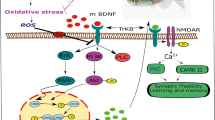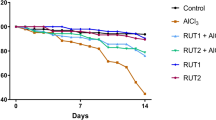Abstract
Parkinson’s disease is a progressive neurodegenerative disorder that affects mostly elderly people above the age of 60. Previously, we have reported that the ethoxylated chalcone derivative (E)-1-(4-ethoxyphenyl)-3-(fluorophenyl)prop-2-en-1-one (E7) showed potent, reversible, and competitive MAO-B inhibition with an IC50 value of 0.053 μm. The present study aims to investigate the anti-Parkinson activity of compound E7 in a haloperidol-induced animal model of mice. The disease was induced with haloperidol (1 mg/kg, intraperitoneal route) once daily for 21 days. E7 was given at dose levels of 10, 20, and 30 mg/kg/day for 21 days, consecutively. Behavioural tests were carried out during and at the end of the study. Biochemical analyses such as oxidative stress biomarkers and neurotransmitters were quantified on the brain homogenate at the end of the study. Behavioural results showed that there is a marked improvement in locomotor activity and motor coordination in the treatment group. Oxidative stress biomarkers such as SOD, CAT, and GSH levels were increased dose-dependently with a maximum at 30 mg/kg, whereas the dose-dependent decrease (30 mg/kg) in the MDA and nitrite levels were observed in the treatment groups. Levels of neurotransmitters, such as dopamine, serotonin, and noradrenaline, were increased in the treatment groups while dopamine and noradrenaline levels were more than in the standard treated group. MAO-B level was also decreased dose dependently in the treatment group in comparison with the control group. Based on the findings, it was concluded that the E7 compound exhibited anti-Parkinson activity which was more evident at 30 mg/kg oral dose as evaluated by the haloperidol-induced animal model of mice.
Graphical abstract








Similar content being viewed by others
Data availability
The datasets used and analysed during the current study are available from the corresponding author on reasonable request.
References
Abdel-Salam OM, El-Shamarka ME-S, Salem NA, Gaafar AE-DM (2012) Effects of Cannabis sativa extract on haloperidol-induced catalepsy and oxidative stress in the mice. EXCLI J 11:45–58
Bais S, Gill NS, Kumar N (2015) Neuroprotective effect of Juniperus communis on chlorpromazine induced Parkinson disease in animal model. Chin J Biol Article ID 542542
Balestrino R, Schapira AHV (2020) Parkinson disease. Eur J Neurol 27:27–42
Binda C, Hubalek F, Li M, Castagnoli N, Edmondson D, Mattevi A (2006) Structure of the human mitochondrial monoamine oxidase b: new chemical implications for neuroprotectant drug design. Neurology 67(7 suppl 2):S5–S7
Datta S, Jamwal S, Deshmukh R, Kumar P (2016) Beneficial effects of lycopene against haloperidol induced orofacial dyskinesia in rats: Possible neurotransmitters and neuroinflammation modulation. Eur J Pharmacol 771:229–235
Deacon RM (2013). Measuring motor coordination in mice. J Vis Exp 75:e2609
Delaville C, Deurwaerdère PD, Benazzouz A (2011) Noradrenaline and Parkinson’s disease. Front Syst Neurosci 5:31
DEWS PB (1953) The measurement of the influence of drugs on voluntary activity in mice. Br J Pharmacol Chemother 8:46–48
Di Monte DA, Chan P, Sandy MS (1992) Glutathione in Parkinson’s disease: a link between oxidative stress and mitochondrial damage? Ann Neurol 32(Suppl):S111–S115
Dröge W (2012) Free radicals in the physiological control of cell function. Physiol Rev 82:47-95
Fernandez HH (2012) Updates in the medical management of Parkinson’s disease. Cleve Clin J Med 79:28-35
Guglielmi P, Mathew B, Secci D, Carradori S (2020) Chalcones: unearthing their therapeutic possibility as monoamine oxidase B inhibitors. Eur J Med Chem 205:112650
Huang X, Xiaokaiti Y, Yang J, Pan J, Li Z, Luria V, Li Y, Song G, Zhu X, Zhang HT, O'Donnell JM, Xu Y (2018) Inhibition of phosphodiesterase 2 reverses gp91phox oxidase-mediated depression- and anxiety-like behavior. Neuropharmacology 143:176–185
Jankovic J (2008) Parkinson's disease: clinical features and diagnosis. J Neurol Neurosurg Psychiatry 79:368–376
Joy M, Mathew B, Sudarsanakumar C (2018) structural features of safinamide: a combined hirshfeld surface analysis & quantum chemical treatment. Chem Data Collect 17-18:404–414
Kulikov A, Bazovkina D, Kondaurova E, Popova N (2008) Genetic structure of hereditary catalepsy in mice. Genes, Brain and Behavior 7:506–512
Lakshminarayanan B, Baek SC, Lee JP, Kannappan N, Mangiatordi GF, Nicolotti O, Subburaju T, Kim H, Mathew B (2019). Ethoxylated head of chalcones as a new class of multi-targeted MAO inhibitors. ChemistrySelect 4;6614–6619.
Lew M (2007). Overview of Parkinson's disease. Pharmacotherapy 27:155S-160S
Lowry OH, Rosebrough NJ, Farr AL, Randall RJ (1951) Protein measurement with the Folin phenol reagent. J Biol Chem 193(1):265–75
Luong TN, Carlisle HJ, Southwell A, Patterson PH (2011) Assessment of motor balance and coordination in mice using the balance beam. J Vis Exp 49:2376
Mathew B (2020). Privileged pharmacophore of FDA approved drugs in combination with chalcone framework: a new hope for Alzheimer’s treatment. Comb Chem High Throughput Screen. 2020;23:842-846
Mathew B, Haridas A, Uçar G, Baysal I, Adeniyi AA, Soliman ME, Joy M, Mathew GE, Lakshmanan B, Jayaprakash V (2016) Exploration of chlorinated thienyl chalcones: a new class of monoamine oxidase-B inhibitors. Int J Biol Macromol 91:680–695
Mathew B, Haridas A, Uçar G, Baysal I, Joy M, Mathew GE, Lakshmanan B, Jayaprakash V (2016a) Synthesis, biochemistry, and computational studies of brominated thienyl chalcones: a new class of reversible MAO-B inhibitors. ChemMedChem 11:1161–1171
Mathew B, Mathew GE, Uçar G, Baysal I, Suresh J, Vilapurathu JK, Prakasan A, Suresh JK, Thomas A (2015) Development of fluorinated methoxylated chalcones as selective monoamine oxidase-B inhibitors: synthesis, biochemistry and molecular docking studies. Bioorg Chem 62:22–29
Mathew B, Oh JM, Baty RS, Batiha GE, Parambi DGT, Gambacorta N, Nicolotti O, Kim H (2021) Piperazine-substituted chalcones: a new class of MAO-B, AChE, and BACE-1 inhibitors for the treatment of neurological disorders. Environ Sci Pollut Res Mar 20:1–12. https://doi.org/10.1007/s11356-021-13320-y
Mathew B, Parambi DGT, Mathew GE, Uddin MS, Inasu ST, Kim H, Marathakam A, Unnikrishnan MK, Carradori S (2019) Emerging therapeutic potentials of dual-acting MAO and AChE inhibitors in Alzheimer’s and Parkinson’s diseases. Arch Pharm (Weinheim) 352:e1900177
Mathew B, Uçar G, Mathew GE, Mathew S, Kalatharakkal Purapurath P, Moolayil F, Mohan S, Varghese Gupta S (2016b) Monoamine oxidase inhibitory activity: methyl- versus chlorochalcone derivatives. ChemMedChem 11:2649–2655
Ohkawa H, Ohishi N, Yagi K (1979) Assay for lipid peroxides in animal tissues by thiobarbituric acid reaction. Anal Biochem 95(2):351–8
Parambi DGT, Saleem U, Shah MA, Anwar F, Ahmad B, Manzar A, Itzaz A, Harilal S, Uddin MS, Kim H, Mathew B (2020) Exploring the therapeutic potentials of highly selective oxygenated chalcone based mao-B inhibitors in a haloperidol-induced murine model of Parkinson’s disease. Neurochem Res 45:2786–2799
Politis M, Niccolini F (2015) Serotonin in Parkinson’s disease. Behav Brain Res 277:136–145
Prakash KG, Bannur BM (2019) Neurobehavioral Effects of Losartan on Rotenone Induced Parkinsonism in Rats. Indian J Public Health Res Dev 10(9)
Rahman H, Eswaraiah, M (2008) Simple spectroscopic methods for estimating brain neurotransmitters, antioxidant enzymes of laboratory animals like mice: a review. Pharmatutor Art 1244:1–12
Ribas V, García-Ruiz C, Fernández-Checa JC (2014) Glutathione and mitochondria. Front Pharmacol 5:151
Saleem U, Raza Z, Anwar F, Ahmad B, Hira S, Ali T (2019a) Experimental and Computational Studies to Characterize and Evaluate the Therapeutic Effect of Albizia lebbeck (L.) Seeds in Alzheimer's Disease. Medicina (Kaunas) 55(5):184
Saleem U, Raza Z, Anwar F, Chaudary Z, Ahmad B (2019b) Systems pharmacology based approach to investigate the in-vivo therapeutic efficacy of Albizia lebbeck (L.) in experimental model of Parkinson's disease. BMC Complement Altern Med 19:352
Sanawar M, Saleem U, Anwar F, Nazir S, Akhtar MF, Ahmad B, Ismail T (2020) Investigation of anti-Parkinson activity of dicyclomine. Int J Neurosci 11:1–14.
Sasidharan R, Baek SC, Sreedharannair Leelabaiamma M, Kim H, Mathew B (2018) Imidazole bearing chalcones as a new class of monoamine oxidase inhibitors. Biomed Pharmacother 106:8–13
Sasidharan R, Eom BH, Heo JH, Park JE, Abdelgawad MA, Musa A, Gambacorta N, Nicolotti O, Manju SL, Mathew B, Kim H (2021) Morpholine-based chalcones as dual-acting monoamine oxidase-b and acetylcholinesterase inhibitors: synthesis and biochemical investigations. J Enzyme Inhib Med Chem 36:188–197
Sasidharan R, Manju SL, Uçar G, Baysal I, Mathew B (2016) Identification of indole-based chalcones: discovery of a potent, selective, and reversible class of MAO-B inhibitors. Arch Pharm (Weinheim) 349:627-637.
Schapira AH, Fox SH, Hauser RA, Jankovic J, Jost WH, Kenney C, Kulisevsky J, Pahwa R, Poewe W, Anand R (2017) Assessment of safety and efficacy of safinamide as a levodopa adjunct in patients with Parkinson’s disease and motor fluctuations: a randomized clinical trial. JAMA Neurol 74:216–224
Seppi K, Weintraub D, Coelho M, Perez-Lloret S, Fox SH, Katzenschlager R, Hametner EM, Poewe W, Rascol O, Goetz CG, Sampaio C (2011) The movement disorder society evidence-based medicine review update: treatments for the non-motor symptoms of Parkinson’s disease. Mov Disord 3:S42–S80
Shiotsuki H, Yoshimi K, Shimo Y, Funayama M, Takamatsu Y, Ikeda K, Takahashi R, Kitazawa S, Hattori N (2010) A rotarod test for evaluation of motor skill learning. J Neurosci Methods 189:180–185
Skinner JW, Christou EA, Hass CJ (2019) Lower extremity muscle strength and force variability in persons with Parkinson disease. J Neurol Phys 43:56–62
Soltaninejad K, Kebriaeezadeh A, Minaiee B, Ostad SN, Hosseini R, Azizi E, Abdollahi M (2003) Biochemical and ultrastructural evidences for toxicity of lead through free radicals in rat brain. Hum Exp Toxicol 22:417–423
Suresh J, Baek SC, Ramakrishnan SP, Kim H, Mathew B (2018) Discovery of potent and reversible MAO-B inhibitors as furanochalcones. Int J Biol Macromol 108:660–664
Talpate KA, Bhosale UA, Zambare MR, Somani RS (2014) Neuroprotective and nootropic activity of Clitorea ternatea Linn.(Fabaceae) leaves on diabetes induced cognitive decline in experimental animals. J Pharm Bioallied Sci 6(1):48–55
Vishal PK, Oh JM, Khames A, Abdelgawad MA, Nair AS, Nath LR, Gambacorta N, Ciriaco F, Nicolotti O, Kim H, Mathew B (2021) Trimethoxylated halogenated chalcones as dual inhibitors of MAO-B and BACE-1 for the treatment of neurodegenerative disorders. Pharmaceutics 13(6):850
Yasui K, Baba A (2006) Therapeutic potential of superoxide dismutase (SOD) for resolution of inflammation. Inflamm Res 55:359–363
Zhang X, Lu L, Liu S, Ye W, Wu J, Zhang X (2013) Acetylcholinesterase deficiency decreases apoptosis in dopaminergic neurons in the neurotoxin model of Parkinson’s disease. Int J Biochem Cell Biol 45:265–272
Zhuang C, Zhang W, Sheng C, Zhang W, Xing C, Miao Z (2017) Chalcone: a privileged structure in medicinal chemistry. Chem Rev 117:7762–7810
Acknowledgements
The authors extend their appreciation to the Deanship of Scientific Research (DSR) at King Khalid University (KKU), Abha, Saudi Arabia, for funding this work through the Research Group Project under the grant number: R.G.P/159/42.
Funding
Deanship of Scientific Research (DSR) at King Khalid University (KKU), Abha, Saudi Arabia, for funding this work through the Research Group Project under the grant number: R.G.P/159/42.
Author information
Authors and Affiliations
Contributions
B. Mathew synthesized the molecule, planned the study, and edited the manuscript. N. Maliyakkal, U. Saleem, F. Anwar, M. A. Shah, B. Ahmad, F. Umer, M. A. A. Almoyad, D. G. T. Parambi, and A. A. Beeran have performed the biological evaluation. Data curation and writing the original draft preparation done by B. Mathew, L.R. Nath, and L. Aleya.
Corresponding authors
Ethics declarations
Ethics approval and consent to participate
The research ethical committee of “Riphah International University, Lahore” vide reference no. of REC/RIPS-LHR/041.
Consent for publication
Not applicable.
Conflict of interest
The authors declare no competing interests.
Additional information
Responsible editor: Philippe Garrigues
Publisher’s note
Springer Nature remains neutral with regard to jurisdictional claims in published maps and institutional affiliations.
Rights and permissions
About this article
Cite this article
Maliyakkal, N., Saleem, U., Anwar, F. et al. Ameliorative effect of ethoxylated chalcone-based MAO-B inhibitor on behavioural predictors of haloperidol-induced Parkinsonism in mice: evidence of its antioxidative role against Parkinson’s diseases. Environ Sci Pollut Res 29, 7271–7282 (2022). https://doi.org/10.1007/s11356-021-15955-3
Received:
Accepted:
Published:
Issue Date:
DOI: https://doi.org/10.1007/s11356-021-15955-3




